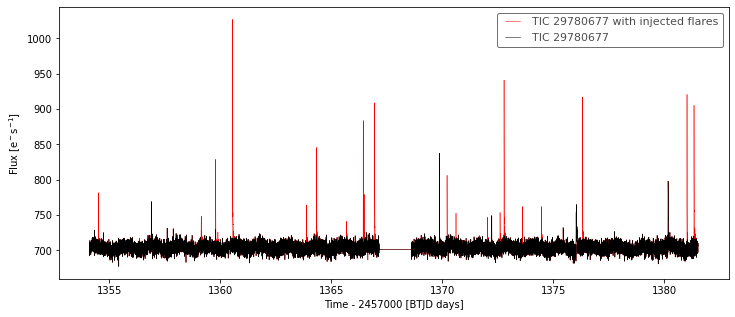Synthetic Flare Injection and Recovery¶
To characterize how well the de-trending and flare finding procedures actually find and characterized flares in a light curve you can inject synthetic flares into it and run the procedures to compare the recovered events to the injected ones. Shapes of flares are created using the piecewise model generated in Davenport et al. (2014)
Experimental feature: Available from the GitHub repository only at the moment: In AltaiPony, the shapes of the flares are generated using the new continuous, and analytic flare model from Tovar Mendoza et al. (2022). The analytical model is an update to the piecewise model generated in Davenport et al. (2014). Using a combination of improved Kepler light-curve processing, an improved flare parameterization from Jackman et al. (2018), and a Gaussian process detredning technique to account for background starspot variability, an updated analytic and continuous flare template was generated to model the white-light flare events on active stars. You can switch between the Davenport et al. (2014) and the Mendoza et al. (2022) models by passing **{"model":"davenport2014"} or **{"model":"mendoza2022"} to flc.sample_flare_recovery().
To run a series of injections, call the sample_flare_recovery() method on a FlareLightCurve.
from altaipony.lcio import from_mast
flc = from_mast("TIC 29780677", mode="LC", c=2, mission="TESS")
flc = flc[0].detrend("savgol")
flc, fake_flc = flc.sample_flare_recovery(inject_before_detrending=True, mode="savgol",
iterations=50, fakefreq=1, ampl=[1e-4, 0.5],
dur=[.001/6., 0.1/6.])
flc is the original light curve with a new attribute fake_flares, which is a DataFrame that includes the following columns:
amplitude: the synthetic flare’s relative amplitudeduration_d: the synthetic flare’s duration in days [1]ed_inj: injected equivalent duration in secondspeak_time: time at which the synthetic flare flux peaksall columns that appear in the flares attribute of FlareLightCurve, see here. If the respective row has a value, the synthetic flare was recovered with some results, otherwise AltaiPony could not re-discover this flare at all.
fake_flc is just like the original one, but without the fake_flares attribute. Instead, its flux contains synthetic flares from the last iteration run by sample_flare_recovery. We return it because it is often useful to see what one actually injects:
import matplotlib.pyplot as plt
fig, ax = plt.subplots(figsize=(12,5))
fakeflc.plot(ax=ax, c="r", label="TIC 29780677 with injected flares")
flc.plot(ax=ax, c="k")

Visualizing results¶
Let’s pick GJ 1243, a famous flare star, inject and recover some flares and look at the results. We follow the same step as before, but inject about 1000 synthetic flares. The setup below produces the minimum number of 1 flare per light curve chunk per iteration, and the TESS light curve of GJ 1243 is split into two uniterrupted segments, therefore, we run 500 iterations. You can get faster results by increasing fakefreq.
from altaipony.lcio import from_mast
flc = from_mast("GJ 1243", mode="LC", c=15, mission="TESS")
flc = flc.detrend("savgol")
flc, fake_flc = flc.sample_flare_recovery(inject_before_detrending=True, mode="savgol",
iterations=500, fakefreq=.01, ampl=[1e-4, 0.5],
dur=[.001/6., 0.1/6.])
We can now look at what fraction of the injected equivalent duration of flares with different recovered amplitudes and durations is recovered:
fig = flc.plot_ed_ratio_heatmap(flares_per_bin=.3)
plt.title("GJ 1243")

Similarly, we can illustrate what fraction of flares with different injected amplitudes and full-width-at-half-maximum values \(t_{1/2}\) in Davenport et al. (2014) is recovered:
fig = flc.plot_recovery_probability_heatmap(flares_per_bin=.3)
plt.title("GJ 1243");

Flare characterization¶
What can we do with all these synthetic flares? We can use them to characterize the flare candidates in the original light curve. To do this, call the characterize_flares method on your FlareLightCurve:
flc = flc.characterize_flares(ampl_bins=10, dur_bins=10)
This method will tile up your sample of fake flares into amplitude and duration bins twice. First, it will tile up the sample into a matrix based on the recovered amplitude and durations. Second, it will do the same with the injected properties, and so include also those injected flares that were not recovered.
The first matrix can be used to map each flare candidate’s recovered equivalent duration to a value that accounts for losses dealt to the ED by photometric noise, and introduced by the de-trending procedure (if you chose inject_before_detrending=True above). The typical injected amplitude and duration of flares in that tile of the matrix can then be used by the second matrix to derive the candidate’s recovery probability from the ratio of lost to recovered injected flares.
The results from this mapping are stored in the flares attribute, which now contains the following additional columns in the table:
dur:= tstop - tstarted_ratio: ratio of recovered ED to injected ED in the synthetic flares in the matrix tile that contains flares with measured properties that are most similar to the candidate flare.ed_ratio_count: number of synthetic flares in the tileed_ratio_std: standard deviation of ED ratios in the tileed_corr:= rec_err / ed_ratioed_corr_err: quadratically propagated uncertainties, includinged_rec_erranded_ratio_std
As in ed_ratio but with amplitude:
amplitude_ratioamplitude_ratio_countamplitude_ratio_stdamplitude_corramplitude_corr_err: uncertainty propagated fromamplitude_ratio_std
As in amplitude_ratio but with duration in days:
duration_ratioduration_ratio_countduration_ratio_stdduration_corrduration_corr_err
As in the columns but now for recovery probability:
recovery_probability: float between 0 and 1recovery_probability_countrecovery_probability_std
“Properties” always refers to amplitude and duration or FWHM.
For a subset of these parameters, flc.flares could look like this:

Footnotes